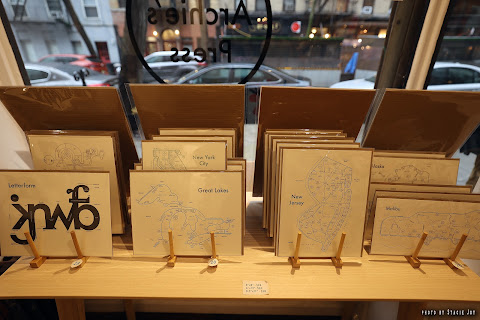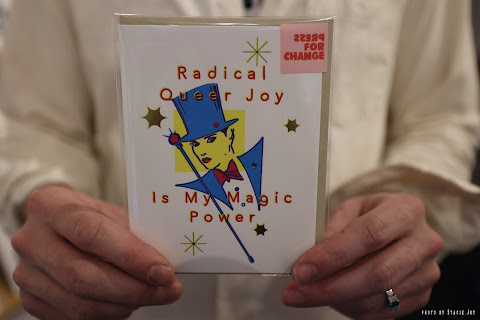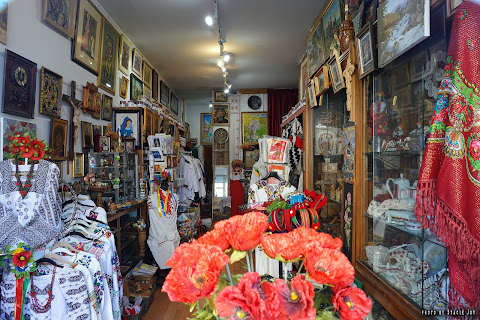Text and photos by Stacie Joy
I’m hoping Shahrzad Ghadjar, artist/owner of female stoner-art-inspired shop
Spooksvilla + Friends at 309 E. Ninth St. between First Avenue and Second Avenue will allow me behind the shop curtain to see her studio.
I’m fascinated with seeing where artists and craftspeople create, and after taking some photos of the store’s merchandise, I get the opportunity to do just that. We sit down to talk about demonic inspiration, her history in the neighborhood and the role advocacy plays in her work.
Where did the idea for the Spooksvilla brand come from? Where do you draw inspiration for your work, and what influences you?
Initially, it wasn’t a brand; it was a way for me to make art under a different name. When I started working at this shop in my neighborhood in Los Angeles, I would go through all this inventory from these different small creative companies and see how — mostly female! — artists were making it work for themselves.
On top of that, the owner was making her own products, and she taught me a lot about how to run your own business. I started to see that there was a way for me to make money off of my illustrations if I put them on usable items. I liked that I could have complete control over what I was doing and get paid on my own terms.
I started off with a couple pocket mirrors, three prints, some greeting cards and jewelry. I set up a table at this club night at a spot called
Club Los Globos in Silverlake and all my friends came to support me, which was great. From there, I would sell at the Hollywood and Silverlake farmers markets every week and that’s where I met a ton of people that told me about other markets to try. By then, I had already put out
Dinosaurs Smoking Weed, which people were loving, and I started to hand-draw stickers for lighters.
The first like, 500 lighters I sold were all original drawings. I would spend an outrageous amount of time on them, and they would sell in the first 30 minutes of a market. I’d be like, Great — what do I sell now? I feel like the lighters have become my calling card and I really like that.
Inspiration is a hard one. I’m all over the place with influences. Surrealism has always been my jam. I love a good cartoon. Definitely astrology and tarot — I’m a huge
Alejandro Jodorowsky person, which is why we have his book on tarot in the shop.
I also love erotica, photographic or literary, which is why I have Anais Nin, Eric Stanton,
Tom Bianchi and
Araki books hanging around here. I pretty much only buy books for the shop by people I was influenced by. Love a Harmony Korine movie. Big fan of Nan Goldin. Obsessed with
Francesca Woodman.
Over the past couple of years, I’ve really leaned into my Iranian-ness. I spent a lot of summers in Iran hanging with my family and they made sure I saw the culture. Palaces covered in mirror work, ceramics, hand-knit carpets, gardens, vibes. My aunts bought me art books that I would casually dive into when I got home and those have always influenced me a lot.
There’s this one book filled with old mystical Iranian iconography that I incorporate into my drawings. It’s just pages of symbols.
There is a lot of imagery in Iranian poetry. My dad just repeats different lines from old poems to me over and over until it sticks and then sometimes I draw a picture, so I don’t forget it. The demon babes I draw are all supposed to be jinni, and I’m trying to learn more about those guys.
The mirror piece I have in the shop is an homage to
Monir Farmanfarmaian, an incredible Iranian artist who made huge mirror mosaics. She worked in this traditional art form called Āina-kāri — mirror work — and made it her own, so I’m also trying to do something similar where I take the idea of Āina-kāri and throw some of my demon babes into the mix. Figuring out a way to combine the Western and Eastern vibes within me.
You hung out on the block the shop is on as a teen. What did you think of the block at the time? Did you ever imagine you’d be running a business here one day?
I spent a ridiculous amount of time on Ninth Street and St. Mark’s Place. Honestly, mainly St. Mark’s and just sitting at the cube back when it was a little island in the middle of the cars. I loved it! The East Village was always the place to be when I was growing up. I spent my high school years hanging at Mud Coffee with friends and “studying.” Smoked a lot of cigarettes and drank beers on the stoop across the street from the shop. Nobody was carding so we could go to the bar. It was great!
I became friends with some of the different personalities on St. Mark’s. All of their shops have moved from the block now. As a kid, my parents would take me to
Khyber Pass because they had good kabob and were close to our apartment. I spent a lot of time with Boris [Zuborev] at
East Village Shoe Repair listening to his stories and just watching him do business. I bought all my shoes from him.
Whenever I’d come by, he’d pull out a pair of shoes from a giant trash bag that fit perfectly. He still does that when I go see him i
n Bushwick.
The dream was always to live in the East Village but not necessarily run a business. I never thought I’d own a business. It wasn’t even on my radar. I thought I was going to make artsy movies that would play at museums, and most people would walk past but there would be maybe four people who thought it was really cool.
What kind of creative work were you doing before launching Spooksvilla? Were you living in Los Angeles? What drew you back to NYC?
I spent about ten years in LA. I went out there for college and it was ROUGH. It was definitely a culture shift. Once I found my crew, everything got so much better! We were all trying to do things in film so we would all work on each other’s projects and were open to new ideas and really supportive.
The best thing I did during those years was VJ at a couple clubs around LA. Possibly the most creatively fulfilled I’ve ever felt. Some friends and I would shoot visuals specific to the event and then would live mix them on a projector to the club music. It was SO. FUN. We definitely set up the vibe for the nights. I remember people going crazy to the music and visual combo.
But unfortunately, it didn’t pay the bills so I was also doing freelance video editing work and casually working in postproduction on a reality TV show. That was mind-numbing. Even the people I worked with were like, “I have a feeling even if we offer you a job on the next show, you’re gonna say no,” and they were right.
I was doing these pop-up markets every week and finally I got in with
Artists & Fleas when they opened in the Arts District. Once I did that a couple times, I was offered a spot selling at Artists & Fleas in Williamsburg and I took it!
Has reaction to your work and shop changed since marijuana decriminalization? If so, how?
The only real difference I’ve noticed since decriminalization is that older people are less standoffish when they see Dinosaurs Smoking Weed. There were a couple markets in LA I had parents dragging their kids/teenagers away from my booth because they just saw the word “weed.” Lots of scowls back then.
I guess people are more likely to see the lighters and Dinosaurs Smoking Weed as goofy, which it always was. But now it’s socially acceptable to smoke weed so these conservative types can loosen up a bit.
It kind of blows my mind that just a couple years ago it was such an ordeal to smoke weed in the city and now it’s just OK. We’ve gone from going into random people’s cars to buy weed to just walking into a smoke shop. It’s kind of wild.
Advocacy regarding human rights issues seems to play a big part in your life. How has that affected your art?
Oh man, I should be doing way more than I am. I would like to get more involved in the community. Right now all I really do is show up to protests when I can and donate to bail relief and WNYC!
You know who I think about a lot when I’m drawing these demon babes? Medusa. I’ve drawn different versions of Medusa my whole life. She is just the most epic character to me. I mean she’s this crazy monster with snake hair that turns men into stone. But why did that happen to her? Because she was raped by Poseidon in Athena’s temple and Athena got pissed! Come on! How is that fair?
Now she’s walking around traumatized, with snake hair and whenever she looks at people they turn to stone. History has this babe written off as a monster, but none of it was her fault. And I guess I look at all these jinni and demons wondering what their perspective is on the situations they’re in. Are they really evil or did something happen to them and then they were just over it?
Another chick I have in my mind a lot is this character Gordafarid from the
Shahnameh, an Iranian epic poem that all Iranians know about. She went out in men’s armor and almost defeated this beloved male character in the book, Sohrab, but mainly she distracted his army for so long that her kingdom was able to escape before Sohrab and his army could take over. I love that. She’s such a bad bitch.
Ultimately, I just love strong women, whether they’re demons or heroes.
There are elements of some of that in my work. I basically only draw women and they all strike me as super strong, fierce ladies. They do what they want when they want, and they don’t care what anyone has to say about it. I think I’ve dreamed up this universe of all-female demons that I fuck with.
My whole thing with demons or jinni is that they’re mischievous goofs. So my demon babes are super powerful creatures that can be perceived as scary or evil but are also just having their idea of a good time. It’s kind of like humans, right? You can’t be all bad or all good. There’s some balance in there.
What’s next for you and the shop? Any future plans?
I’m working on my second mirror mural, so I’m super stoked! I’d like to do four by the end of the year. Also, sitting around doing a lot of drawings for the shop so that the Spooksvilla brand stays strong!
For now, I’m just trying to keep the shop stocked with fun stuff that the people want. Maybe I’ll open up in Brooklyn or even LA, but for now, the East Village is all I really care about!
You can keep an eye on what’s happening at Spooksvilla on
Instagram.




















































